语言学2
- 格式:doc
- 大小:30.00 KB
- 文档页数:2



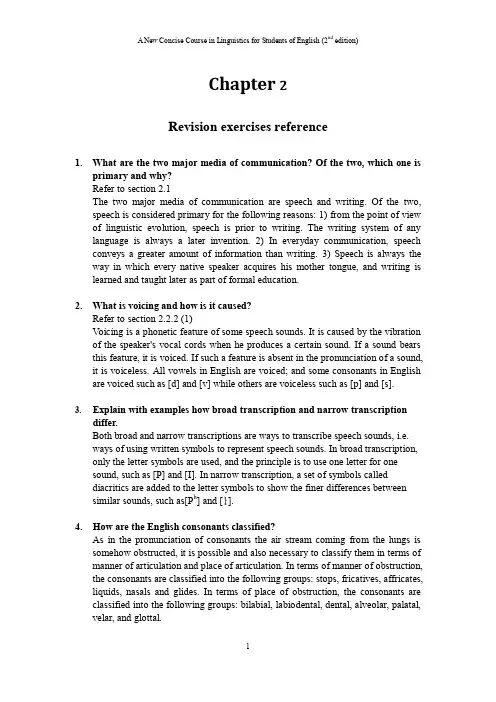
Chapter 2Revision exercises reference1.What are the two major media of communication? Of the two, which one isprimary and why?Refer to section 2.1The two major media of communication are speech and writing. Of the two, speech is considered primary for the following reasons: 1) from the point of view of linguistic evolution, speech is prior to writing. The writing system of any language is always a later invention. 2) In everyday communication, speech conveys a greater amount of information than writing. 3) Speech is always the way in which every native speaker acquires his mother tongue, and writing is learned and taught later as part of formal education.2.What is voicing and how is it caused?Refer to section 2.2.2 (1)V oicing is a phonetic feature of some speech sounds. It is caused by the vibration of the speaker's vocal cords when he produces a certain sound. If a sound bears this feature, it is voiced. If such a feature is absent in the pronunciation of a sound, it is voiceless. All vowels in English are voiced; and some consonants in English are voiced such as [d] and [v] while others are voiceless such as [p] and [s].3.Explain with examples how broad transcription and narrow transcriptiondiffer.Both broad and narrow transcriptions are ways to transcribe speech sounds, i.e.ways of using written symbols to represent speech sounds. In broad transcription, only the letter symbols are used, and the principle is to use one letter for onesound, such as [P] and [I]. In narrow transcription, a set of symbols calleddiacritics are added to the letter symbols to show the finer differences between similar sounds, such as[P h] and [ɫ].4.How are the English consonants classified?As in the pronunciation of consonants the air stream coming from the lungs is somehow obstructed, it is possible and also necessary to classify them in terms of manner of articulation and place of articulation. In terms of manner of obstruction, the consonants are classified into the following groups: stops, fricatives, affricates, liquids, nasals and glides. In terms of place of obstruction, the consonants are classified into the following groups: bilabial, labiodental, dental, alveolar, palatal, velar, and glottal.5.What criteria are used to classify the English vowels?To classify the English vowels, the following criteria can be applied: position of the tongue, openness of the mouth, length of the vowels, and the shape of the lips.According to the position of the tongue, the vowels are classified into front, central and back vowels; according to the openness of the mouth, the vowels are classified into close, semi-close, semi-open, and open vowels; and according to the length of the vowels, they are classified into long vowels and short vowels;and according to the shape of the lips, and the vowels are classified into rounded and unrounded vowels.6.Give the phonetic symbol for each of the following sound descriptions:1)voiced palatal affricate--- [dʒ]2)voiceless labiodental fricative---[f]3)voiced alveolar stop---[d]4)front, close, short---[i]5)back ,semi-open, long ---[ɔ:]6)voiceless bilabial stop---[p]Given the phonetic features of each of the following sounds:1)[d]---voiced alveolar stop2)[l]---voiced alveolar liquid3)[tʃ]---voiceless palatal/alveolar affricate4)[w]---voiced bilabial glide5)[u]---back,close,short(rounded)6)[æ]---front,short,open(unrounded)7.How do phonetics and phonology differ in their focus of study? Who do youthink will be more interested in the difference between, say, [l]and[ɫ], [pʰ]and[P],a phonetician or a phonologist? Why?Refer to section 2.3.1Though both dealing with speech sounds, phonetics and phonology differ in their focus of study in that the former focuses on the speech sounds themselves, their ways of pronunciation, their differences, their classifications, etc., while the latter focuses on the sound system of particular languages and the role sounds play in conveying meaning. Therefore, a phonetician will be more interested in the difference between two sounds.8.What is a phone? How is it different from a phoneme? How are allophonesrelated to a phoneme?Refer to section 2.3.2A phone is simply a speech sound, every actual sound we use or hear inmeaningful linguistic communication. For example, in pronouncing the two words “feel” and “leaf”, we actually use or hear four phones:[f][i:][l]and[~l].A phone differs from a phoneme in that the former is an actual sound we hear andit is the unit of study in phonetics, and the latter is not an audible sound, but an abstract entity, a collection of phonetic features, used as a unit of study in phonology. Take the “feel” and “leaf” example again. While four phones are used or heard in the pronunciation of these two words, only three phonemes are involved, i.e. /f/ /i: / and /l/.A phoneme, though as an abstract entity, is realized as different phones indifferent phonetic contexts. All these different phones are called the allophones of the same one phoneme. For example, the aspirated [pʰ] and the unaspirated [p] are allophones of the same phoneme/p/.9.Explain with examples the sequential rules, the assimilation rule, and thedeletion rule.Sequential rules are rules that govern the combination of sounds in a particular language. For exam ple, why “klib” is a permissible combination of the four sounds in English and why “kbli” is not can only be accounted for by a sequential rule.The assimilation rule assimilates one sound to another by “copying” a feature of a sequential phoneme, thus making the two phones similar. For example, the actual pronunciation of the letter “n” in the word “ incorrect” is not the alveolar [n] but the velar nasal [ŋ] is a manifestation of the assimilation rule at work.The deletion tells us when a sound is deleted although it is orthographically represented. For example, in the pronunciation of such words as sign, design, and paradigm, there is no [g] sound although it is represented in spelling by the letterg. But in their corresponding noun forms signature, designation and paradigmatic,the [g] represented by the letter g is pronounced.10.What are Suprasegmental features? How do the major Suprasegmentalfeatures of English function in conveying meaning?Suprasegmental features refer to those phonological features occurring above the sound segment level. The major Suprasegmental features in English are stress and intonation. The shift of word stress may change the part of speech of words of the same spelling, such as “'progress n.” and “pro'gress v.” , and different stress may cause difference in the meaning of some compound nouns and noun phrases with the same components, such as “'hotdog” and “hot 'dog”. Stressing words that are normally unstressed in a sentence may convey some extra meaning by the speaker.For exam ple, by stressing the pronoun “my” in the sentence “He is driving 'my car” the speaker is emphasizing the fact that the car he is driving is no one else`s but the speaker`s.The three often-used intonations in English are the falling tone, the rising tone, and the fall-rise tone. The basic role they each play is that the falling tone states a fact, the rising tone raises a question, and the fall-raise tone implies some meaning not literally expressed. For example, the same sentence “That`s not the book he w ants” said in the three different intonations convey three different meanings.Supplementary ExercisesI. Decide whether each of the following statements is True or False:1.If two phonetically similar sounds occur in the same environments and they distinguishmeaning, they are said to be in complementary distribution.2. A phone is a phonetic unit that distinguishes meaning.3.English is a tone language while Chinese is not.4.In linguistic evolution, speech is prior to writing.5.In everyday communication, speech plays a greater role than writing in terms of the amountof information conveyed.6.Articulatory phonetics tries to describe the physical properties of the stream of sounds whicha speaker issues with the help of a machine called spectrograph.7.The articulatory apparatus of a human being are contained in three important areas: the throat,the mouth and the chest.8.Vibration of the vocal cords results in a quality of speech sounds called voicing.9.English consonants can be classified in terms of place of articulation and the part of thetongue that is raised the highest.10.According to the manner of articulation, some of the types into which the consonants can beclassified are stops, fricatives, bilabial and alveolar.11.Any sound produced by a human being is a phoneme.12.Distinctive features of sound segments can be found running over a sequence of two or morephonemic segments.II. Fill in each of the following blanks with one word which begins with the letter given:13. A ____ refers to a strong puff of air stream in the production of speech sounds.14.The four sounds /p/,/b/,/m/ and /w/ have one feature in common, i.e., they are all b_______sounds.15.S_________ features are the phonemic features that occur above the level of the segments.They include stress, tone, intonation, etc.16.The rules that govern the combination of sounds in a particular language are called s ____rules.17.P___________ is a discipline which studies the system of sounds of a particular language andhow sounds are combined into meaningful units to effect linguistic communication.18.Depending on the context in which stress is considered, there are two kinds of stress: wordstress and s_________ stress.III. There are four choices following each of the statements below. Mark the choice that can best complete the statement:19.Of all the speech organs, the _______ is/ are the most flexible.A. mouthB. lipsC. tongueD. vocal cords20.__________ is a voiced alveolar stop.A. /z/B. /d/C. /k/D. /b/21.Since /p/ and /b/ are phonetically similar, occur in the same environments and they candistinguish meaning, they are said to be ___________.A. in phonemic contrastB. in complementary distributionC. the allophonesD. minimal pair22. A ____ vowel is one that is produced with the front part of the tongue maintaining the highestposition.A. backB. centralC. frontD. middle23.Distinctive features can be found running over a sequence of two or more phonemicsegments. The phonemic features that occur above the level of the segments are called ____________.A. phonetic componentsB. immediate constituentsC. Suprasegmental featuresD. semantic features24.A(n) ___________ is a unit that is of distinctive value. It is an abstract unit, a collection ofdistinctive phonetic features.A. phoneB. soundC. allophoneD. phoneme。
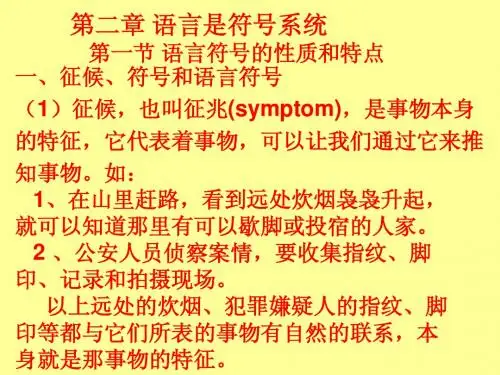
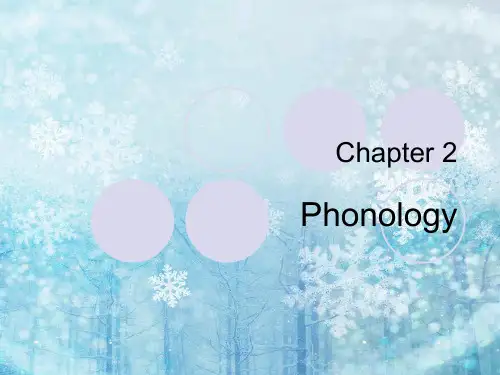
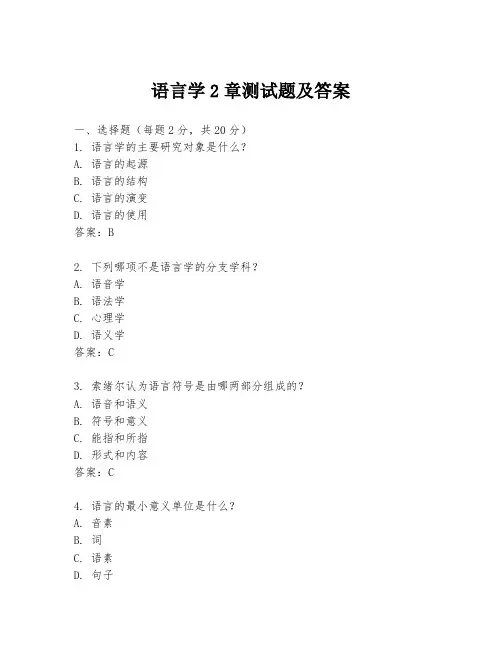
语言学2章测试题及答案一、选择题(每题2分,共20分)1. 语言学的主要研究对象是什么?A. 语言的起源B. 语言的结构C. 语言的演变D. 语言的使用答案:B2. 下列哪项不是语言学的分支学科?A. 语音学B. 语法学C. 心理学D. 语义学答案:C3. 索绪尔认为语言符号是由哪两部分组成的?A. 语音和语义B. 符号和意义C. 能指和所指D. 形式和内容答案:C4. 语言的最小意义单位是什么?A. 音素B. 词C. 语素D. 句子5. 语言的交际功能不包括以下哪一项?A. 信息传递B. 情感表达C. 思维工具D. 艺术创作答案:C6. 语言的规范性主要体现在哪个方面?A. 发音B. 语法C. 词汇D. 所有选项答案:D7. 语言的多样性主要体现在哪些方面?A. 语言结构B. 语言使用C. 语言发展D. 所有选项答案:D8. 语言的演变不包括以下哪一项?A. 语音变化B. 词汇变化C. 语法变化D. 语言消亡答案:D9. 以下哪种现象不属于语言接触?B. 融合C. 分化D. 同化答案:C10. 语言的标准化通常不涉及以下哪一项?A. 发音规范B. 词汇规范C. 语法规范D. 语言的起源答案:D二、填空题(每题2分,共20分)1. 语言学研究的两个主要对象是______和______。
答案:语言;言语2. 索绪尔将语言符号分为______和______。
答案:能指;所指3. 语言的三个基本功能包括______、______和______。
答案:表达功能;交际功能;思维功能4. 语音学研究的是______和______。
答案:语音的产生;语音的感知5. 语用学研究的是______和______。
答案:语境;意义6. 语言的演变包括______、______和______。
答案:语音变化;词汇变化;语法变化7. 语言的接触现象包括______、______和______。
答案:借用;融合;同化8. 语言的多样性表现在______、______和______。
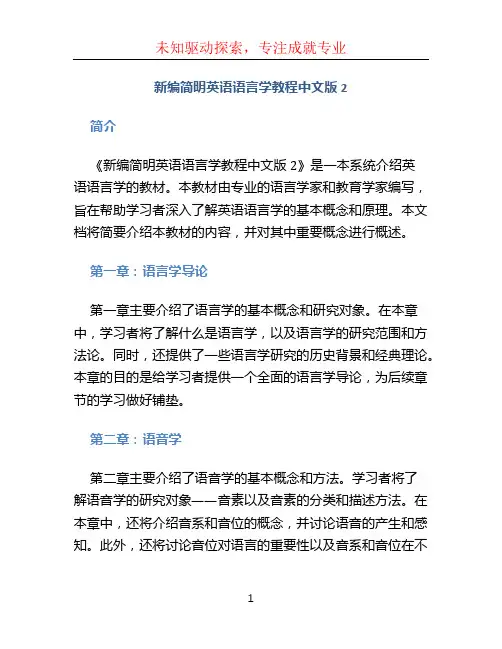
新编简明英语语言学教程中文版2简介《新编简明英语语言学教程中文版2》是一本系统介绍英语语言学的教材。
本教材由专业的语言学家和教育学家编写,旨在帮助学习者深入了解英语语言学的基本概念和原理。
本文档将简要介绍本教材的内容,并对其中重要概念进行概述。
第一章:语言学导论第一章主要介绍了语言学的基本概念和研究对象。
在本章中,学习者将了解什么是语言学,以及语言学的研究范围和方法论。
同时,还提供了一些语言学研究的历史背景和经典理论。
本章的目的是给学习者提供一个全面的语言学导论,为后续章节的学习做好铺垫。
第二章:语音学第二章主要介绍了语音学的基本概念和方法。
学习者将了解语音学的研究对象——音素以及音素的分类和描述方法。
在本章中,还将介绍音系和音位的概念,并讨论语音的产生和感知。
此外,还将讨论音位对语言的重要性以及音系和音位在不同语言间的差异。
通过学习本章内容,学习者将对语音学的基本理论和方法有一个初步了解。
第三章:音系学第三章主要介绍了音系学的研究内容和方法。
在本章中,学习者将学习语音学中的重要概念:音位、语音环境和音变规律。
此外,还将介绍音系学的研究方法,如音位的调查和描述。
通过学习本章内容,学习者将了解音系学在语言研究中的重要性,以及如何通过音系学方法来分析和描述不同语言的音系。
第四章:词汇学第四章主要介绍了词汇学的研究内容和方法。
在本章中,学习者将学习词汇学的基本概念,如词汇的定义和分类。
同时,还将介绍词汇的形态结构和词性。
本章还将介绍词汇的意义和语义关系,并讨论词汇的产生和变化。
通过学习本章内容,学习者将了解词汇学在语言研究中的重要性,以及如何进行词汇的分析和研究。
第五章:句法学第五章主要介绍了句法学的研究内容和方法。
在本章中,学习者将学习句法学的基本概念,如句子的组成和句子的结构。
同时,还将介绍句法分析的方法和理论,如短语结构文法和依存句法。
本章还将讨论句法的意义和句法的变化。
通过学习本章内容,学习者将了解句法学在语言研究中的重要性,以及如何进行句法的分析和研究。
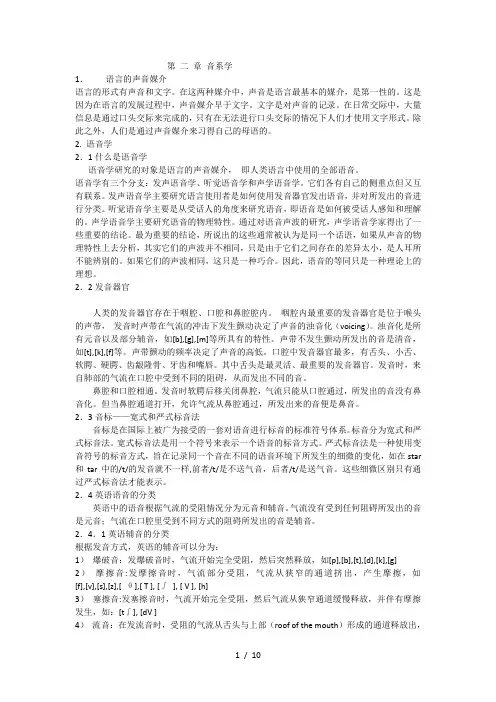
第二章音系学1.语言的声音媒介语言的形式有声音和文字。
在这两种媒介中,声音是语言最基本的媒介,是第一性的。
这是因为在语言的发展过程中,声音媒介早于文字。
文字是对声音的记录。
在日常交际中,大量信息是通过口头交际来完成的,只有在无法进行口头交际的情况下人们才使用文字形式。
除此之外,人们是通过声音媒介来习得自己的母语的。
2. 语音学2.1什么是语音学语音学研究的对象是语言的声音媒介,即人类语言中使用的全部语音。
语音学有三个分支:发声语音学、听觉语音学和声学语音学。
它们各有自己的侧重点但又互有联系。
发声语音学主要研究语言使用者是如何使用发音器官发出语音,并对所发出的音进行分类。
听觉语音学主要是从受话人的角度来研究语音,即语音是如何被受话人感知和理解的。
声学语音学主要研究语音的物理特性。
通过对语音声波的研究,声学语音学家得出了一些重要的结论。
最为重要的结论,所说出的这些通常被认为是同一个话语,如果从声音的物理特性上去分析,其实它们的声波并不相同,只是由于它们之间存在的差异太小,是人耳所不能辨别的。
如果它们的声波相同,这只是一种巧合。
因此,语音的等同只是一种理论上的理想。
2.2发音器官人类的发音器官存在于咽腔、口腔和鼻腔腔内。
咽腔内最重要的发音器官是位于喉头的声带,发音时声带在气流的冲击下发生颤动决定了声音的浊音化(voicing)。
浊音化是所有元音以及部分辅音,如[b],[g],[m]等所具有的特性。
声带不发生颤动所发出的音是清音,如[t],[k],[f]等。
声带颤动的频率决定了声音的高低。
口腔中发音器官最多,有舌头、小舌、软腭、硬腭、齿龈隆骨、牙齿和嘴唇。
其中舌头是最灵活、最重要的发音器官。
发音时,来自肺部的气流在口腔中受到不同的阻碍,从而发出不同的音。
鼻腔和口腔相通。
发音时软腭后移关闭鼻腔,气流只能从口腔通过,所发出的音没有鼻音化。
但当鼻腔通道打开,允许气流从鼻腔通过,所发出来的音便是鼻音。
2.3音标——宽式和严式标音法音标是在国际上被广为接受的一套对语音进行标音的标准符号体系。
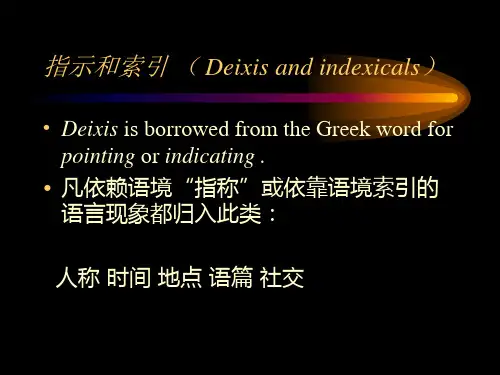
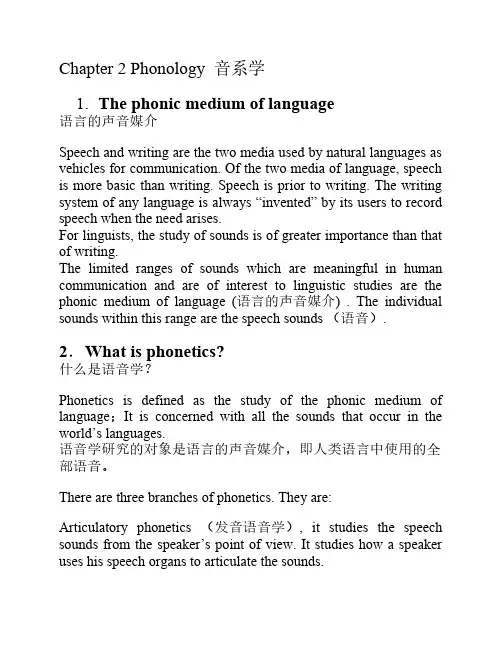
Chapter 2 Phonology 音系学1. The phonic medium of language语言的声音媒介Speech and writing are the two media used by natural languages as vehicles for communication. Of the two media of language, speech is more basic than writing. Speech is prior to writing. The writing system of any language is always “invented” by its users to record speech when the need arises.For linguists, the study of sounds is of greater importance than that of writing.The limited ranges of sounds which are meaningful in human communication and are of interest to linguistic studies are the phonic medium of language (语言的声音媒介) . The individual sounds within this range are the speech sounds (语音). 2.What is phonetics?什么是语音学?Phonetics is defined as the study of the phonic medium of language;It is concerned with all the sounds that occur in the world’s languages.语音学研究的对象是语言的声音媒介,即人类语言中使用的全部语音。
Chapter 2 Speech Sounds2.1 Speech production and perceptionPhonetics is the study of speech sounds. It includes three main areas:1. Articulatory phonetics – the study of the production of speech sounds2. Acoustic phonetics –the study of the physical properties of the sounds produced inspeech3. Auditory phonetics – the study of perception of speech soundsMost phoneticians are interested in articulatory phonetics.2.2 Speech organsSpeech organs are those parts of the human body involved in the production of speech. The speech organs can be considered as consisting of three parts: the initiator of the air stream, the producer of voice and the resonating cavities.2.3 Segments, divergences, and phonetic transcription2.3.1 Segments and divergencesAs there are more sounds in English than its letters, each letter must represent more than one sound.2.3.2 Phonetic transcriptionInternational Phonetic Alphabet (IPA): the system of symbols for representing the pronunciation of words in any language according to the principles of the InternationalPhonetic Association. The symbols consists of letters and diacritics. Some letters aretaken from the Roman alphabet, some are special symbols.2.4 Consonants2.4.1 Consonants and vowelsA consonant is produced by constricting or obstructing the vocal tract at someplaces to divert, impede, or completely shut off the flow of air in the oral cavity.A vowel is produced without obstruction so no turbulence or a total stopping of theair can be perceived.2.4.2 ConsonantsThe categories of consonant are established on the basis of several factors. The most important of these factors are:1. the actual relationship between the articulators and thus the way in which theair passes through certain parts of the vocal tract (manner of articulation);2. where in the vocal tract there is approximation, narrowing, or the obstructionof the air (place of articulation).2.4.3 Manners of articulation1. Stop/plosive: A speech sound which is produced by stopping the air streamfrom the lungs and then suddenly releasing it. In English,[☐ ♌ ♦ ♎ ♑] are stops and [❍ ⏹ ☠]are nasal stops.2. Fricative: A speech sound which is produced by allowing the air stream fromthe lungs to escape with friction. This is caused by bringing the twoarticulators, e.g. the upper teeth and the lower lip, close together but notcloses enough to stop the airstreams completely. In English,[♐ ❆ ♦ ☞ ✞ ♒] are fricatives.3. (Median) approximant: An articulation in which one articulator is close toanother, but without the vocal tract being narrowed to such an extent that aturbulent airstream is produced. In English this class of sounds includes[♦ ❑ ].4. Lateral (approximant): A speech sound which is produced by partiallyblocking the airstream from the lungs, usually by the tongue, but letting itescape at one or both sides of the blockage. [●] is the only lateral in English.Other consonantal articulations include trill, tap or flap, and affricate.2.4.4 Places of articulation1. Bilabial: A speech sound which is made with the two lips.2. Labiodental: A speech sound which is made with the lower lip and the upperfront teeth.3. Dental: A speech sound which is made by the tongue tip or blade and theupper front teeth.4. Alveolar: A speech sound which is made with the tongue tip or blade and thealveolar ridge.5. Postalveolar: A speech sound which is made with the tongue tip and the backof the alveolar ridge.6. Retroflex: A speech sound which is made with the tongue tip or blade curledback so that the underside of the tongue tip or blade forms a stricture with theback of the alveolar ridge or the hard palate.7. Palatal: A speech sound which is made with the front of the tongue and thehard palate.8. Velar: A speech sound which is made with the back of the tongue and the softpalate.9. Uvular: A speech sound which is made with the back of the tongue and theuvula, the short projection of the soft tissue and muscle at the posterior end ofthe velum.10. Pharyngeal: A speech sound which is made with the root of the tongue and thewalls of the pharynx.11. Glottal: A speech sound which is made with the two pieces of vocal foldspushed towards each other.2.4.5 The consonants of EnglishReceived Pronunciation (RP): The type of British Standard English pronunciation which has been regarded as the prestige variety and which shows no regional variation. It has often been popularly referred to as “BBC English” or “Oxford English” because it is widely used in the private sector of the education system and spoken by most newsreaders of the BBC network.articulation. These pairs of consonants are distinguished by voicing, the one appearingon the left is voiceless and the one on the right is voiced.Therefore, the consonants of English can be described in the following way:[p] voiceless bilabial stop[b] voiced bilabial stop[s] voiceless alveolar fricative[z] voiced alveolar fricative[m] bilabial nasal[n] alveolar nasal[l] alveolar lateral[j] palatal approximant[h] glottal fricative[r] alveolar approximant2.5 Vowels2.5.1 The criteria of vowel description1. The part of the tongue that is raised – front, center, or back.2. The extent to which the tongue rises in the direction of the palate. Normally,three or four degrees are recognized: high, mid (often divided into mid-highand mid-low) and low.3. The kind of opening made at the lips –various degrees of lip rounding orspreading.4. The position of the soft palate –raised for oral vowels, and lowered forvowels which have been nasalized.2.5.2 The theory of cardinal vowels[Icywarmtea doesn’t quite understand this theory.]Cardinal vowels are a set of vowel qualities arbitrarily defined, fixed and unchanging, intending to provide a frame of reference for the description of the actualvowels of existing languages.By convention, the eight primary cardinal vowels are numbered from one to eight as follows: CV1[♓], CV2[♏], CV3[☪], CV4[♋], CV5[ ], CV6[ ], CV7[☐],CV8[◆].A set of secondary cardinal vowels is obtained by reversing the lip-rounding for agive position: CV9 – CV16. [I am sorry I cannot type out many of these. If you want toknow, you may consult the textbook p. 47. – icywarmtea]2.5.3 Vowel glidesPure (monophthong) vowels: vowels which are produced without any noticeable change in vowel quality.V owel glides: V owels where there is an audible change of quality.Diphthong: A vowel which is usually considered as one distinctive vowel of a particular language but really involves two vowels, with one vowel gliding to the other.2.5.4 The vowels of RP[♓] high front tense unrounded vowel[◆] high back lax rounded vowel[☜] central lax unrounded vowel[ ] low back lax rounded vowel2.6 Coarticulation and phonetic transcription2.6.1 CoarticulationCoarticulation: The simultaneous or overlapping articulation of two successive phonological units.Anticipatory coarticulation: If the sound becomes more like the following sound, as in the case of lamp, it is known as anticipatory coarticulation.Perseverative coarticulation: If the sound displays the influence of the preceding sound, as in the case of map, it is perseverative coarticulation.Nasalization: Change or process by which vowels or consonants become nasal.Diacritics: Any mark in writing additional to a letter or other basic elements.2.6.2 Broad and narrow transcriptionsThe use of a simple set of symbols in our transcription is called a broad transcription. The use of more specific symbols to show more phonetic detail is referredto as a narrow transcription. The former was meant to indicate only these soundscapable of distinguishing one word from another in a given language while the latterwas meant to symbolize all the possible speech sounds, including even the minutestshades of pronunciation.2.7 Phonological analysisPhonetics is the study of speech sounds. It includes three main areas: articulatory phonetics, acoustic phonetics, and auditory phonetics. On the other hand, phonology studies the rules governing the structure, distribution, and sequencing of speech sounds and the shape of syllables.There is a fair degree of overlap in what concerns the two subjects, so sometimes it is hard to draw the boundary between them. Phonetics is the study of all possible speech sounds while phonology studies the way in which speakers of a language systematically use a selection of these sounds in order to express meaning. That is to say, phonology is concerned with the linguistic patterning of sounds in human languages, with its primary aim being to discover the principles that govern the way sounds are organized in languages, and to explain the variations that occur. 2.8 Phonemes and allophones2.8.1 Minimal pairsMinimal pairs are two words in a language which differ from each other by only one distinctive sound and which also differ in meaning. E.g. the English words tie anddie are minimal pairs as they differ in meaning and in their initial phonemes /t/ and /d/.By identifying the minimal pairs of a language, a phonologist can find out which soundsubstitutions cause differences of meaning.2.8.2 The phoneme theory2.8.3 AllophonesA phoneme is the smallest linguistic unit of sound that can signal a difference inmeaning. Any of the different forms of a phoneme is called its allophones. E.g. inEnglish, when the phoneme /☐/ occurs at the beginning of the word like peak/☐♓/, it is said with a little puff of air, it is aspirated. But when /☐/ occurs in theword like speak /♦☐♓/, it is said without the puff of the air, it is unaspirated. Boththe aspirated [☐♒] in peak and the unaspirated [☐=] in speak have the same phonemicfunction, i.e. they are both heard and identified as /☐/ and not as /♌/; they are bothallophones of the phoneme /☐/.2.9 Phonological processes2.9.1 AssimilationAssimilation: A process by which one sound takes on some or all the characteristics of a neighboring sound.Regressive assimilation: If a following sound is influencing a preceding sound, we call it regressive assimilation.Progressive assimilation: If a preceding sound is influencing a following sound, we call it progressive assimilation.Devoicing: A process by which voiced sounds become voiceless. Devoicing of voiced consonants often occurs in English when they are at the end of a word.2.9.2 Phonological processes and phonological rulesThe changes in assimilation, nasalization, dentalization, and velarization are all phonological processes in which a target or affected segment undergoes a structuralchange in certain environments or contexts. In each process the change is conditioned ortriggered by a following sound or, in the case of progressive assimilation, a precedingsound. Consequently, we can say that any phonological process must have three aspectsto it: a set of sounds to undergo the process; a set of sounds produced by the process; aset of situations in which the process applies.We can represent the process by mans of an arrow: voiced fricative →voiceless / __________ voiceless. This is a phonological rule. The slash (/) specifies theenvironment in which the change takes place. The bar (called the focus bar) indicatesthe position of the target segment. So the rule reads: a voiced fricative is transformedinto the corresponding voiceless sound when it appears before a voiceless sound.2.9.3 Rule ordering[No much to say, so omitted – icywarmtea]2.10 Distinctive featuresDistinctive feature: A particular characteristic which distinguishes one distinctive sound unit of a language from another or one group of sounds from another group.Binary feature: A property of a phoneme or a word which can be used to describe the phoneme or word. A binary feature is either present or absent. Binary features are also used to describe the semantic properties of words.2.11 SyllablesSuprasegmental features: Suprasegmental features are those aspects of speech that involve more than single sound segments. The principal suprasegmental features are syllables, stress, tone, and intonation.Syllable: A unit in speech which is often longer than one sound and smaller than a whole word.Open syllable: A syllable which ends in a vowel.Closed syllable: A syllable which ends in a consonant.Maximal onset principle: The principle which states that when there is a choice as to where to place a consonant, it is put into the onset rather than the coda. E.g. The correct syllabification of the word country should be / ✈⏹♦❑♓/. It shouldn’t be / ✈⏹♦❑♓/ or / ✈⏹♦❑♓/ according to this principle.2.12 StressStress refers to the degree of force used in producing a syllable. In transcription, a raised vertical line [ ] is used just before the syllable it relates to.。
语言学概论(2)复习要点Chapter 61、three approaches to the study of language and cognition P129 para.22、Psycholinguistics(definition) P130 para.23、Psycholinguistics has its roots in... P130 para.34、Six subjects of research within psycholinguistics P130 para.45、Three central topics in psycholinguistics P131 para.16、Four stages of children's acquisition of language P131-P1337、cohort theory P135 para.58、minimal attachment theory P138 para.29、schemata P139 para.3 (或见课件)10、image schema P147.para.111、metaphor(definition) P148 para.612、3 kinds of conceptual metaphors P149. para.213、metonomy (definition)P151. para.214、3 ICMs in ontological realms P151. para.315、blending theory P155. Para.6Chapter 71、sociolinguistics (definition)P159. para.22、speech community, register P160. Para.33、Sapir-Whorf Hypothesis P162. para.24、Linguistic determinism, Linguistic relativity P163 para.15、Three objectives for us to teach culture in our language class P169 para.76、Some social factors that influence our language behavior in a social context P171 para.47、William Labov, the professor in the linguistics department of the University ofPennsylvania,.the founder of the discipline of quantitative sociolinguistics8、the features of women register P172 para.29、linguistic sexism P173 para.110、A sociolinguistic study of society (macrosociolinguistics)A sociolinguistic study of language (microsociolinguistics):P173 para3 -- P174 para1--311、Pidgin and Creole(definition) P174 para. 3(见课件)Chapte r 101、computational linguistics P242, para. 22、Distinguish CAI, CAL & CALL P243, para.4--53、Four phases of CALL development P244 para. 2-- P245 para. 14、Machine Translation (MT) P247 para. 15、Two types of Machine Translation and the definition P247 para. 16、Development of MT(3 subtitles) P247--P2487、MT research methods (4 types) P249--P2508、the relationship between MT and human translation P253 para. 2--49、Corpus and Corpus Linguistics (definition) P25410、The roles of corpus data (5 subtitles) P258-- P259Chapter 111、applied linguistics(definition) P266 Para.12、Dr. Ellis, who is known as the "Father of Second Language Acquisition", has served as the Director of the Institute of Language Teaching and Learning at the University of Auckland.3、Input-based teaching methods (7 approaches) (见课件)4、input hypothesis (definition) P270, para. 45、Interlanguage(definition) P271, last para.6、Dr. David C. Nunan , Director of the English Centre and Chair Professor of Applied Linguistics, University of Hong Kong. He is currently serving as President of TESOL and teaches at Newport Asia Pacific University and Hong Kong University.7、Two broad types of tasks: real-world tasks and pedagogical tasks P273, para.48、Syllabus and curriculumP277, para.2; P277, para.49、Types of syllabus P 279--P280 (4 subtitles)10、Components of a syllabus P285 para.2-311、language transfer P287 para.312、Contrastive Analysis P287 para.413、Error and mistake P289 para.214、In terms of the source of errors, errors ... P289 para.3In terms of the nature of errors, errors... P289 para.4Chapter 121、About Saussure P294 para.1, para. 3, Line 1-22、The contributions of Saussure to modern linguistics (见课件)3、The differences between modern linguistics and traditional grammar(见课件)4、The most important contribution of Prague School to linguistics P296. para.3;P297.para.15、Functional Sentence Perspective P298-P299 para.16、theme and rheme P299 para.27、Representatives in London School P301.para.3-48、M A K Halliday and his Systemic-Functional GrammarSpecial features of Systemic-Functional Grammar P307 para.3;P307 para.5 —P308 para.19、transitivity choices P310 (learn to analyze examples)10、Representatives in American Structuralism :Boas , Sapir, Bloomfield11、Bloomfield contribution to English linguistics:P320-P32112、behaviorism (definition) P320 para.213、Noam Chomsky and his TG GrammarThe publication of his Syntactic Structures(1957) marked the beginning of the Chomskyan revolution14、Five stages of development of TG grammar Perspective P326, para.315、The innateness hypothesis P327 para.2LANGUAGE ACQUISITION DEVICE P327 para.316、Main features and influences of TG grammar (课件)I. Term Defining:1、Psycholinguistics is the study of psychological aspects of language. It usually studies thepsychological states and mental activity with the use of language, with focus on the process of language acquisition, language comprehension and language production. It takes upon itself the job of exploring the biological basis of human language, critical periods for child language acquisition, and the relationship between language and though t.2、Cognitive Linguistics: A newly established approach to the study of language. It is thescientific study of the relation between the way we communicate and the way we think. It is an approach to language that is based on our experience of the world and the way we perceive and conceptualize it.3、Garden Path sentences are sentences that are initially interpreted with a different structure thanthey actually have. It typically takes quite a long time to figure out what the other structure is if the first choice turns out to be incorrect. They have been “led up the garden path,” fooled into thinking the sentence has a different structure than it has. Examples are The horse raced past the barn fell. The boat floated downstream sank. While Mary was mending the sock fell off her lap.4、Corpus: is a collection of linguistic data, either compiled as written texts or as a transcription ofrecorded speech. The main purpose of a corpus is to verify a hypothesis of language.5、Corpus linguistics: an approach to investigating language structure and use through the analysisof large databases to real language examples stored on computer.6、Interlanguage is the type of language constructed by second or foreign language learners whoare still in the process of learning a language / a language system between the target language and the learner’s native language. Interlanguage is a dynamic language system, which is constantly moving from the departure level to the native-like level. It is formed when the learner attempts to learn a new language,and it has features of both the first language and the second language but is neither.7、B ehaviorism:This principle was put forward by American descriptive linguist L. BloomfieldFor Bloomfield, linguistics is a branch of psychology. And specifically of the positivistic brand of psychology known as BEHA VIOURISM. Behaviorism is a principle of scientific method, based on the belief that human beings cannot know anything they have not experienced.Behaviorism in linguistics holds that children learn language through a chain of “stimulus-response reinforcement”, and the adult’s use of language is also a process of STIMULUS-RESPONSE.8、M ethaphor: Metaphors are actually cognitive tools that help us structure our thoughts andexperiences in the world around us. It involves the comparison of two concepts in that one is constructed in terms of the other. It is often described in terms of a target domain and a source domain. The target domain is the experience being described by the metaphor and the source domain is the means that we use in order to describe the experience.9、I nput hypothesis learners acquire language as a result of comprehending input addressed tothem. Krashen brought forward the concept of “i+ 1” principle, i.e. t he language that learners are exposed to should be just far enough beyond their current competence that they can understand most of it but still be challenged to make progress. Input should neither be so far beyond their reach that they are overwhelmed, nor so close to their current level that they are not challenged at all.10、Sapir-Whorf Hypothesis: It is a belief that our language helps mould our way of thinking and,consequently, different languages may probably express speakers’ unique ways of understanding the world. On the one hand, language may determine our thinking patterns. On the other hand, similarity between languages is relative. The greater their structural differentiation is, the morediverse their conceptualization of the world is. As this hypothesis was put forward by the American anthropological linguists Sapir and Whorf, it has often been called the Sapir-Whorf Hypothesis.II. Questions:1. What are the contributions of Saussure to modern linguistics?The revolution aspect of modern linguistics is that relations and relation system are given great priority, which was insisted by Saussure. Saussure’s contribution to modern linguistics involves the following aspects:First, Saussure proposed the direction for linguistic research and explained the tasks of linguistics. Saussure believed that language was a system constituted by signs and relations, and the aim of linguists was to analyze the system including identifying the units, explaining their relations and the rules governing their combination. Later on, it almost becomes the definition of linguistic research. Structural approach started by Saussure covers nearly all the important schools in modern linguistics, Prague school, Copenhagen school, Functionalism, American structuralism, even Norm Chomsky.Second, Saussure believed that language was a system of sense. He held that the linguistic sign unit was a concept and a sound-image. The combination of a concept and a sound-image made up the whole of the linguistic sign. Saussure called the concept signified and the sound-image signifier. The relationship between signified and signifier was arbitrary. For Saussure, meaning existed only because there were differences of meaning, and it was these differences of meanings that enabled one to establish the articulation of linguistic form.Third, Saussure proposed some basic concepts and their distinctions which were influential. They are langue and parole, synchronic and diachronic, prescriptive and descriptive, syntagmatic and paradigmatic relation.2. Why should language teachers learn some knowledge of linguistics?Some knowledge of linguistics will not only help language teachers to better understand the nature of language, but also helps them better understand how to teach language. Theoretical views of language explicitly or implicitly inform the approaches and methods adopted in language teaching. Language teachers do need theories of language in order to teach language effectively, and they need to know at least how the language they teach works. To discover the real language and to obtain some understanding of it, language teachers may well turn to linguistics. Many language learning theories are proposed based on certain linguistic theories. In fact, knowledge in linguistics lies at the root of understanding what language learners can learn, how they actually learn and what they learn ultimately. Therefore, linguistics has always played an important role in the studies of language acquisition and learning.3. In what way are language and computer related?With the development of the computer technology and internet system, more and more people touched upon the computer field. Computer has been used in the classroom for foreign language teaching and learning. CAI stands for computer-assisted instruction, which means the use of a computer in a teaching program. CAL stands for computer-assisted learning, which means the use of computer in both teaching and learning. Following CAI and CAL, CALL appears. It refers to the use of a compute in the teaching or learning of a second or foreign language. If CAI or CAL deals with teaching and learning in general, then CALL deals with language teaching and learning in particular.4、Why do we need to teach culture in our language classroom? Give examples if necessary.1) Language not only reflects culture but also is part of culture.2) Language is an indispensable carrier of culture and culture finds a better representation through language use.3) Learning a foreign language is inseparable from learning its culture. The influence of cultural knowledge on the linguistic perfomance of language learners has been identified and highlighted.4) It has repeatedly been found that learners who lack sufficient knowledge about the target language can hardly become active and appropriate language usres in their target language.5) For these reasons, the information concerning cultural differences has rightly been introduced in language classrooms of different kinds for enhancing learners’ cultural consciousness and improving their performance in cross-cultural contexts of communication.5、What is the relationship between MT and Human Translation?At the beginning of the new century, it is already apparent that MT and human translation can and will co-exist in harmony. When translation has to be of “publishable”quality, both human translation and MT have their roles.For the translation of texts where the quality of output is much less important, machine translation is often an ideal solution. It is undeniable that there are still faults in all present actual translations produced. One can still find those errors that no human translators would ever commit, such as wrong pron., incorrect choice of terms, etc. Translation is not an operation that preserves meaning. Three types of knowledge are needed so that MT systems can be improved: linguistic knowledge independent of context ( semantics); linguistic knowledge that relates to context, sometimes called pragmatic knowledge (pragmatics); common sense/real world knowledge ( non-linguistic).For the one-to-one interchange of information probably always need a human translator. As for spoken language translation, there must surely always be market for the human translator.6、How do you understand Chomsky’s LANGUAGE ACQUISITION DEVICE?Chomsky believes that language is somewhat innate, and that children are born with a Language Acquisition Device, which is a unique kind of knowledge that fits them for language learning. He argues the child comes into the world with specific innate endowment, not only with general tendencies or potentialities, but also with knowledge of the nature of the world, and specifically with the knowledge of the nature of language. According to this view, children are born with knowledge of the basic grammatical relations and categories, and this knowledge is universal. The categories and relations exist in all human languages and all human infants are born with knowledge of them. According to him, the study of language, or the structure of language, can throw some light on the nature of the human mind. This approach to language is a reaction against behaviorism in psychology and empiricism in philosophy, making linguistics a branch of psychology.。
Acquisition is a process similar to the way children acquire their first language. It is a subconscious process without minute learning of grammatical rules
Learning as another route, refers to conscious efforts to learn the second language knowledge by learning the rules and talking about the rules
Register
The type of language which is selected as appropriate to the type of situation is a register
Stops p b t d k g
Fricatives f v s z
Bilabial p b
Labio-dental F v
Alveolar t d s z
Velar k g
Context: it is generally considered as constituted by the knowledge shared by the hearer and the speaker
Knowledge of what language use
Knowledge of what have been said before
Knowledge about the world in general
Knowledge about the specific situation in which linguistic communication is taking place Knowledge about each other
The naming theory
The conceptualist view
contextualism Time and place hearer and speaker actions they are performing
objectives exist in the situation
behaviorism
synonymy Dialectal synonym
stylistic synonym
synonym differ in emotive and evaluative meaning
collocational synonym
semantically different synonym
polysemy
Homonymy homophones 同音异议
Homographs
Hyponymy 上下意关系
Superordinate 坐标词
Hyponymy 下意词
X entails Y X 是小范围等同于Y is the entailment of X
X presupposes Y X 是以Y为前提的Y为条件等同于Y is the prerequisite of X
Interlanguage is defined as an abstract system of the learner’s target language and it has now been widely refer to the linguistic expressions learners produce especially the wrong or not idiomatic ones。